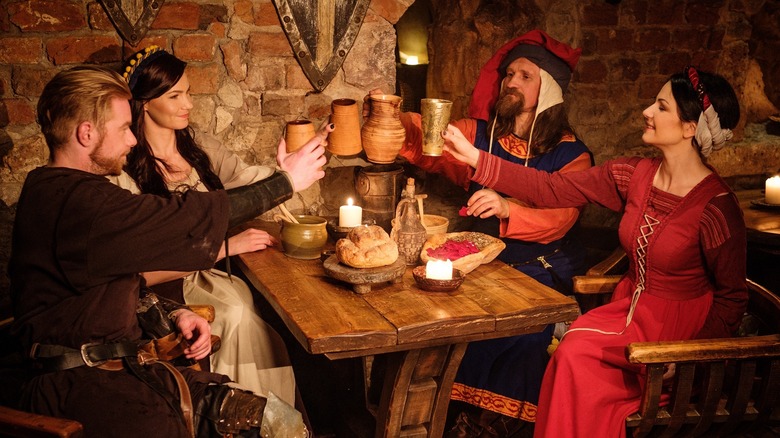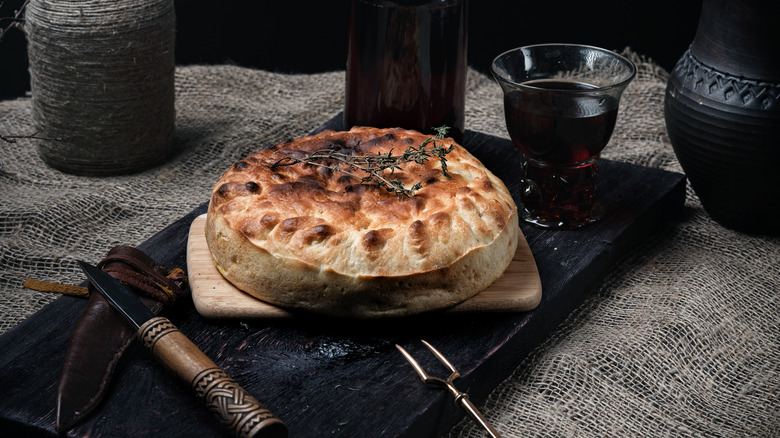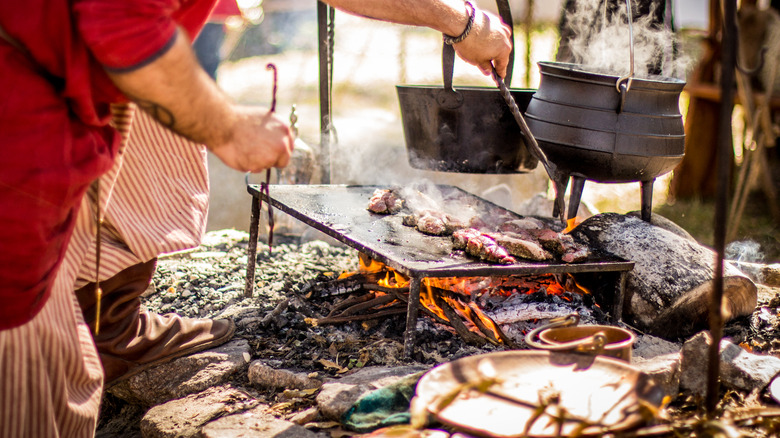The Truth About The Dangers Of Medieval Fast Food
Just as people today often don't have enough time, money, and/or interest when it comes to making home-cooked meals, people living in medieval times had similar issues. The solution to these problems? Fast food. Throughout history, people have needed quick, easy, portable food that than easily be consumed on the move. Per the Pennsylvania State University Center for Medieval Studies, the concept of fast food has been around since Roman times. Adults living in urban areas in small dwellings often didn't have access to food storage, fuel with which to cook, or tools such as pots, pans, and utensils, let alone the actual meat and vegetables to cook in the first place. As early as the late 12th century, there was a "fast food restaurant" located on the banks of the Thames river in London where hungry travelers or city dwellers could stop in any time of day or night and find a variety of food ready to eat at a range of price points.
For centuries, it remained relatively rare for people to have access to home cooking necessities. One study of life in 14th-century Colchester, England concluded that just 3% of tax-paying households had their own kitchen. Artisans, workers, and poor widows often lived in dwellings without hearths, let alone cooking stoves. Money had to be spent on crucial expenses such as rent and milk. Just as it is now, time was at a premium for people who spent much of their day working and caring for their families.
Medieval fast food: Just what was in those pasties?
What kinds of fast food did medieval diners enjoy? According to the Penn State University Center for Medieval Studies, meat pies and pasties — a folded-over, filled crust, like a small calzone — were popular; they were portable and easy to eat on the go, like a Big Mac. Bread was the mainstay of medieval diets, as it was inexpensive, kept for a while, and was made from readily available flour. Fast food consisted of lots of bread products, including hot cakes, pancakes, and wafers in addition to pies and pasties. Furthermore, historians have found evidence of regulations forbidding bakers to charge more than a penny to put a customer's meat into a pastry and bake it, making it even more of a bargain for people with little cash.
Another similarity between medieval fast food and modern fast food is the bad reputation with which these eateries were saddled. In medieval times, the cooks themselves who prepared and sold these foods were often seen as dirty and dishonest. Sources indicate that some cooks made food from spoiled sausage pork, rabbit, geese, and offal, reheated and sold days-old pasties on the verge of spoiling, and sold beef pasties as venison. Per Martha Carlin in her article "'What say you to a piece of beef and mustard?': The Evolution of Public Dining in Medieval and Tudor London," available via JSTOR, in William Langland's Middle English poem "Piers Plowman," cooks are listed as a group regularly punished by authorities because "they poison the people privily and oft."
The cons of the medieval diets
To make matters worse, many cooks were disguising tainted food with the overuse of spices and herbs, says Building History. Along with the spoiled food some cooks were serving to their customers, and even without it, the medieval diet wasn't exactly beneficial in any way. Fast food during that era had questionable preparation practices and wasn't regulated. Similar to today — fast food is still considered an unhealthy food option, although we have better food practices.
But whatever social class someone occupied during that time, a meat pie here and there didn't stand a chance against their overall poor diets. So in the long run those quick eats at those riverside cookshops wouldn't have made a difference. Per Lords and Ladies, the medieval diet was lacking in many areas, and the poor and elite all suffered by not getting adequate vitamins and nutrients for proper bodily functions. It resulted in several health conditions common at that time. Lucky for the poor, due to social attitudes that said fruits and vegetables were for peasants, they had better access and opportunity to eat them. But another attitude of that time also said that fresh produce couldn't be eaten raw and had to be cooked, per Abbey Medieval Festival. This meant that a lot of significant nutrients were lost in addition to an already lacking diet.
For the most part, the medieval diet mostly consisted of what we call carbohydrates today. But even with the health risks that came with their food practices, some experts say it fares better than what people today actually eat (via BBC).


